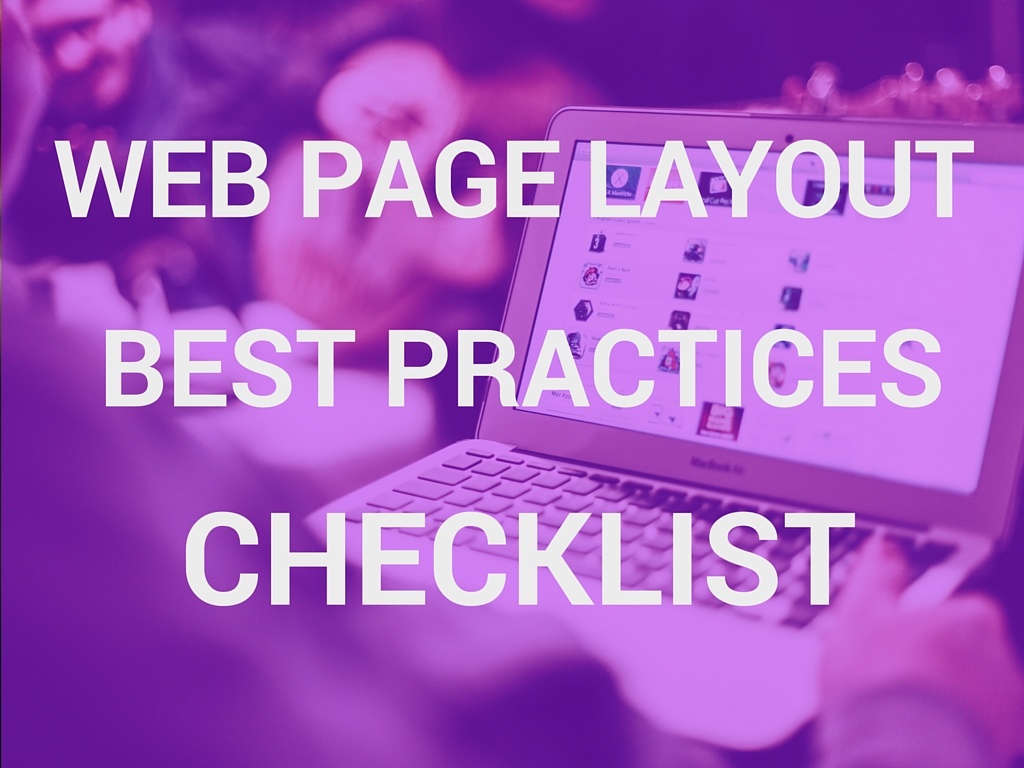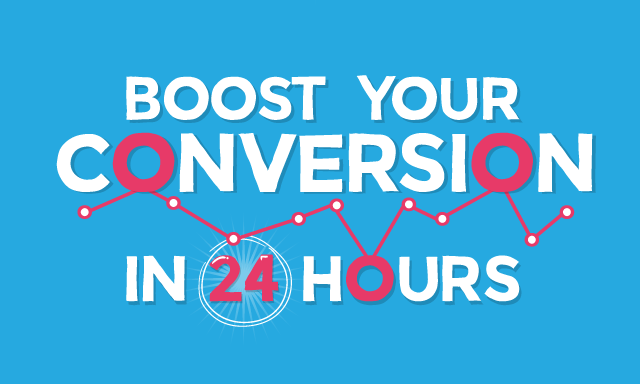“If it ain’t broke, don’t fix it.” I’m not sure who offered that advice but clearly, they weren’t...
There are many factors that contribute to a well-optimised website, in terms of onpage optimisation, and it can get rather confusing. Here are the most important aspects you should focus on to take your SEO to the next level.

Technical Checks
Use this checklist to cover all your onpage optimisation.
Page Speed
It’s important your website has a fast load speed.
Your website's page speed affects the user’s experience when they’re looking through your website; if it’s efficient it could lead to higher conversions. It also ensures potential visitors don’t go to your competitor’s website instead because their site loads faster than yours. It’s such a simple fix and can help minimise lost opportunities.
If you have an ecommerce website, having a slow site can cost you sales. If it’s struggling to display a page, the potential customer may feel it’s a poor quality site and resist from entering their payment details. Many consumers abandon their baskets before checkout because the process is too slow.
Site speed is a Google ranking factor. This means Google will likely rank sites higher if they load quickly. So, basically, the faster the better. You can do a simple test to ensure your website is up to scratch.
Use this free tool to check your page speed: https://tools.pingdom.com/
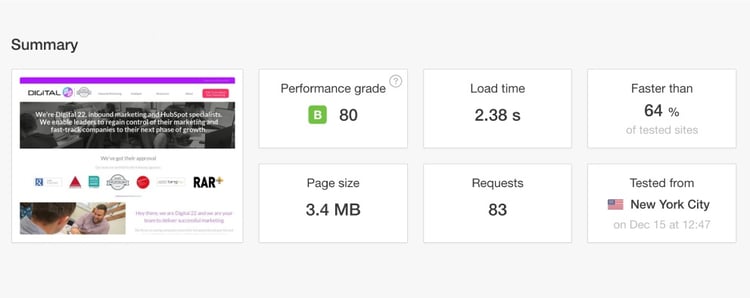
Sitemap
A sitemap is exactly what it says on the tin; a file that maps out your site, listing every single page. This can be easily accessed by the bots who crawl, read and index your site.
Use can easily check your sitemap here: http://seositecheckup.com/tools/sitemap-test
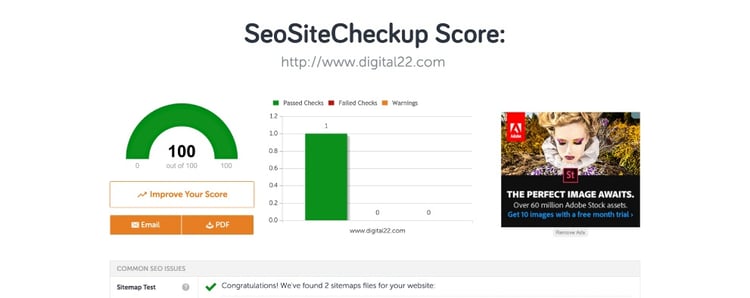
If you don’t have one, create one. It's quick and easy, and could help your site rank higher in search rankings and attract more business.
Robots txt
It is important to have a robot txt file to ensure Google knows what to read and what to ignore on your website. It will read the robots.txt and regulate what the Google bots see before the crawl begins. It will index anything you want to show and help rank new pages.
You can use these requests to manage how your site is crawled:
-User-agent
This commands a specific robot to crawl the site.
-Disallow
Disallow requests stop bots from crawling pages you don’t want to be crawled.
It is a good idea to include the sitemap location in your robots txt too so the bots can find all your pages to crawl.
You can check your own robots txt file by visiting your homepage and on the end of your URL by adding /robots.txt like this www.yoursite.com/robots.txt
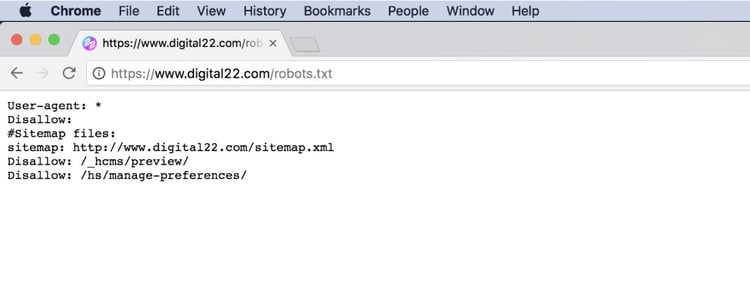
It’s not a good idea to have a no robots file at all because your entire website will be crawled and this includes any back end pages you don’t want to be indexed by the bots.
404 Pages
Over time, you may decide to remove some of your old pages.
404 pages appear when a visitor goes to a website page that has been removed or deleted. The error will usually appear like “404: the page you are looking for cannot be found.” However, these pages will likely still have links going to them, from other parts of your website, your blog and from other sites.
I’m sure most of you have been frustrated by a 404 page in the past as it’s often just blank.
If a visitor lands on a 404 page they are likely to click off your website and visit a different site. It is very important to 301 redirect any pages you’ve removed to give visitors the best experience possible. 301 redirects are used to redirect visitors to the new page (if it’s been moved elsewhere) or to the homepage. It reduces the chance of a visitor losing interest and going to another site.
You can use this free tool to check for broken links on your website: http://www.brokenlinkcheck.com/
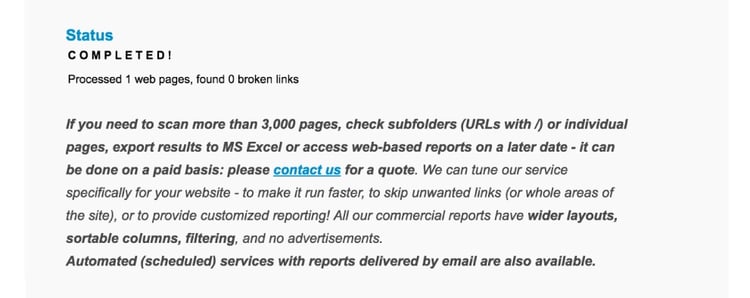
This will help you find links that need to be redirected elsewhere.
If your website has a high bounce rate (this means users are clicking on your site and then clicking back), it could suggest you have many 404 pages. As bounce rate is an important Google ranking factor, you need to keep on top of it.
If you have a Google Console account, the site crawl section is a great tool for this as it reports on all the 404 pages across the website.
Duplicate Content Checks
It is important to make sure the content on your website is original and helpful. By being helpful, you’re helping the searcher and by being original, Google will appreciate your fresh content. Duplicating other website content is a no-no. Copying content from other websites will result in your site being penalised and you will lose valuable search rankings.
Many ecommerce sites have similar products but the description and text on each page should be unique to avoid duplication. Google’s algorithms are intelligent and by reading a website they can determine which sites provide excellent information and others that have copied from other sites.
To be in Google’s good books and to increase the chances of getting higher rankings, it is worth writing more helpful and relevant content on your website pages. For the pages you want to rank highly, it’s recommended to write at least 300-400 words to help boost your rankings.
The best tip when it comes to writing content is to make sure it’s original, relevant and good quality.

You can check your website for duplicate content here: http://www.copyscape.com/
If you have a Moz account, the site crawl section is a great tool for this as it flags the duplicate pages.
www vs non-www
There are many different URL structures but we are focusing on the www structure versus the non-www structure.
www is the website URL structure that looks like this https://www.yourwebsite.com/
A non-www is the website URL structure that looks like this https://yourwebsite.com/
You want to choose one or the other to be your main URL. If you have both, your website has two versions which can cause numerous problems.
Personally, I’d make my main URL www so the non-www redirects to the www version of your website.

One of the reasons I favour this option is when sites link to you, it's normally the www version so I prefer to stick with that. In my opinion, I don't think Google minds either way as long as whichever you choose is constant throughout your site to avoid confusion.
If you don’t choose one or the other, this can cause duplication issues as the two URLs will compete for rankings, just make sure if someone searched the non-www they are redirected to your www version or vice versa.
It must be constant throughout the site to avoid confusion. Check if your site redirects by checking the www and non-www and seeing where it leads too.
Mobile Friendly Check
This is a relatively recent Google ranking factor. Over the last few years, more people are using their mobiles to access the internet and search the web. Google was aware of this increasing trend and to help searchers, they’ve made it a must that all websites are mobile friendly to rank highly in mobile searches.
Google recently took this one step further by using mobile websites as the primary format (over the desktop) when indexing sites. This means Google is deciding rankings for all searches based on your mobile site.
Mobile friendly websites are responsive to any mobile or handheld device. Visitors can easily explore the website on a mobile device. Sites that are not mobile friendly usually require you to zoom in and swipe across the page.
If your website is not mobile responsive, you could be damaging your search rankings. Google has said it’s a key ranking factor and you cannot ignore it.
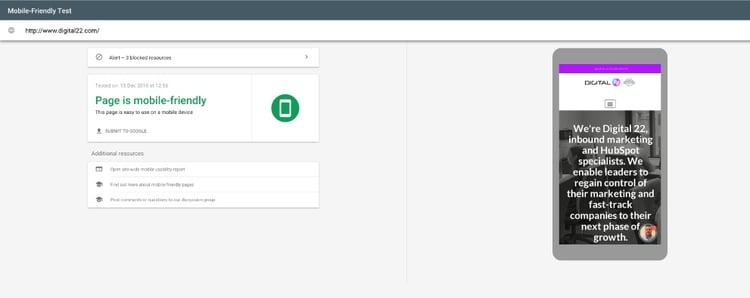
Check your site is mobile friendly here: https://search.google.com/search-console/mobile-friendly
If it's not, invest in getting up to speed as recent Google changes have shown accelerated mobile pages are performing higher over desktop.
It's also vitally important that you have a grasp of your AMP pages. Google has been creating default AMP pages, but you need to format your own in order to keep control of CTA locations and so on.
Read more about AMP here.
Schema Markup
Schema markup is micro data, inserted into your HTML, which tells search engines what it is looking at and how it should be treated and this helps search engines give more accurate results for their users. It is a code that can be added onto your pages so your content can be displayed to users based on their search queries, in an improved context.
It's a great move to take your SEO to the next level, especially when we can see Google search results going even more visual. This is because schema markup can help spiders identify images, pull data and content in order to include your page in rich snippets and results.
For example, schema helps establish contextual information, helping businesses differentiate themselves from, say, a famous celebrity with the same surname as the name of their restaurant.
Also, it’s hard for search engines to understand dates as there are different formats in different countries, so schema markup can help ensure the information is read correctly.
It is often in the list format displaying event times, reviews and pricing, which then helps improve the chance of being featured in showtime carousels, Google shopping and other rich cards.
It can help SEO by improving your organic visibility as your content is then being found more effectively.
If you need an update on schema markup, read our blog on it here.
SEO Best Practice for Website Pages
Title Of Your Page
An H1 should be used for your title on the page. Try to use a keyword in the title or headline if possible. It should tell the reader what this page is about in a few words. Try and make it attention grabbing and tailored to your ideal customer. Think about your ideal buyer persona if you need ideas.
First Paragraph
Go one step further than the title and introduce to the visitor what the page is about and the different services available. It is important to think about why they’ve come to this specific page and what part of the buyer’s journey they’re in. This will help you summarise a helpful introduction. Include a keyword if you can (but only if it sounds natural).You must not stuff your page with keywords otherwise Google will penalise you.
Content
Use H2’s and H3’s for any of your subtitles to help them stand out. A large chunk of text can be daunting but breaking it down into sections helps the reader focus on areas that are important to their needs. The sub heading helps contextualise the topic for the reader.
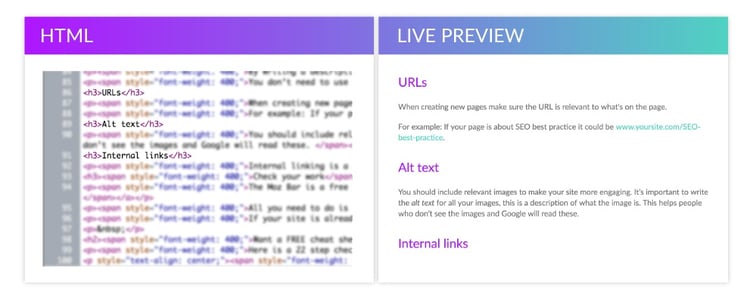
Each website page should have a word count of 300 to 500 words at least. For SEO, it’s beneficial to have more than 500 words, it helps your website stand out from your competitors and signals to Google that you have something important to say. However, the content must be relevant and original.
It is important there is no duplicate content as Google will penalise you and your rankings will suffer.
Throughout your content, you should include your keyword. Years ago, many businesses were guilty of keyword stuffing, this was where writers stuffed the keywords in as many times as they could. You should never do this, Google will think you’re spamming your content and penalise your site. Keywords should be included naturally and sparingly.
For a page that has 500 words you may only use your keywords two or three times. Remember Google’s bots will figure out what keyword you’re optimising for so you don’t need to overstuff your content. Focus on writing helpful, relevant and engaging content that will impress and benefit readers.
Meta Title
To optimise your website page properly you need a meta title, this is displayed in the tab and in search engine listings to help the user find the most appropriate page for their query. The meta title should be 60 to 70 characters and include the primary and secondary keywords (and the brand name and location if possible).

This is one of the most important on page ranking signals so take the time to craft an optimised but user friendly title.
Meta Description
Along with writing the meta title, you need to write a meta description and this is 160 characters long. While meta descriptions are not a Google ranking factor, it’s still important to optimise them to encourage people to click on your listing.

By writing a description about what your web page has to offer and how it will help the searcher, it has the potential to encourage a searcher to visit your site over a competitor’s.
You don’t need to use your keywords in the meta description but it’s recommended because they will appear in bold when a searcher makes a search with the same keywords you’ve used. This can help grab a searcher’s attention and prompt them to click.
URLs
When creating new pages make sure the URL is relevant to what's on the page.
For example: If your page is about SEO best practice it could be www.yoursite.com/SEO-best-practice.
Alt Text
You should include relevant images to make your site more engaging. It’s important to write the alt text for all your images, this is a description of what the image is. This helps people who don’t see the images and Google will read these.
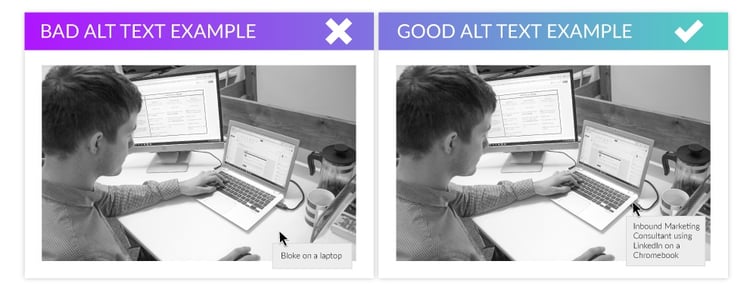
Internal Links
Internal linking is a great idea if there are any blogs you’ve written or other pages that are relevant. This will help build your site strength as well as being very useful for the reader.
Check Your Work
The Moz Bar is a free page grader tool which is great for checking a web page has everything optimised to give it the best chance of ranking https://moz.com/products/pro/seo-toolbar
All you need to do is download the Moz Bar then go to ‘Page Optimisation’ and add the keyword you are targeting to check it’s in the right place. It will tell you what changes are suggested and the factors that have been solved and are properly optimised.
If your site is already live and you’re checking each page, this score can help determine which pages need the most work and as you continue improving and optimising, your website’s rankings will improve.
Want a FREE cheat sheet to increase your Google rankings?
Here is a 22 step checklist to help optimise your SEO and win more organic traffic.

